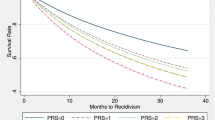Abstract
Previous studies of shock probation have reported mixed effects with regard to recidivism rates. This particular study compared the attributes of a sample of shock and regular probationers and discovered that type of probation was not significantly related to rearrest rates.
Similar content being viewed by others
References
Bohlander, E. (1973)Shock probation; The use of and effectiveness of an early release alternative. Columbus, Ohio: Unpublished doctoral dissertation. The Ohio State University.
Gottfredson, S. and Gottfredson, D. (1980) Screening for risk: A comparison of methods.Crim. Just, and Behavior, 7: 315–330.
Faine, J.R. and Bohlander, E. (1976)Shock Probation: The Kentucky Experience. Bowling Green, Kentucky: Western Kentucky University.
Flanagan, T.J. (1983) Correlates of institutional misconduct among state prisoners: A research note.Criminology, 21: 29–40.
Friday, P.C., Petersen, D. M., and Allen, H.E. (1973) Shock probation: A new approach to crime control.Georgia J. of Corr., 1: 1–13.
Kozuh, J., Guenther, R., Plattsmier, R., and Buckmaster, D. (1980)TAPC shock probation survey. Austin, TX: Texas Adult Probation Commission, Division of Information Services.
Mueller, J. H., Schuessler, K.F., and Costner, H.L. (1977)Statistical reasoning in sociology. Boston: Houghton Mifflin.
Parisi, N. (1980) Combining incarceration and probation.Fed. Prob., 44: 3–12.
Parisi, N. (1981) A taste of the bars.J. of Crim. Law and Crim., 7: 1109–1123.
Patton, J. (1977) Shock probation: A taste of prison.Corr. Mag., December: 49–55.
Petersen, D.M. and Friday, P.C. (1975) Early release from incarceration: Race as a factor in the use of shock probation.J. of Crim. Law and Crim., 66: 79–87.
Pritchard, D. (1979) Stable predictors of recidivism.Criminology, 17: 15–21.
Sykes, G.W., Holmes, R.M. and Revels, J. (1983) Shocked and scared: Prison as a deterrent?APPA Perspectives 7: 1–3.
Vito, G.F. and Allen, H.E. (1981) Shock probation in Ohio: A comparison of outcomes.Int. J. of Off. Ther. and Comp. Crim., 25: 70–76.
Vito, G.F. and Allen, H.E. (1980) Shock probation in Ohio: The use of base expectancy rates as an evaluation method.Crim. Just. and Behavior, 7: 331–339.
Vito, G.F. (1983) Developments in shock probation: A review of research findings and policy implications.Fed. Prob., 48: 22–27.
Vito, G.F. (1978) Shock probation in Ohio: A re-examination of the factors influencing the use of an early release program.Off. Rehab., 3: 123–132.
Waldron, J.A. and Angelino, H.R. (1977) Shock probation: A natural experiment on the effect of a short period of incarceration.The Prison J., 57: 45–52.
Author information
Authors and Affiliations
Rights and permissions
About this article
Cite this article
Vito, G.F., Holmes, R.M. & Wilson, D.G. The effect of shock and regular probation upon recidivism: A comparative analysis. AJCJ 9, 152–162 (1985). https://doi.org/10.1007/BF02887264
Published:
Issue Date:
DOI: https://doi.org/10.1007/BF02887264




